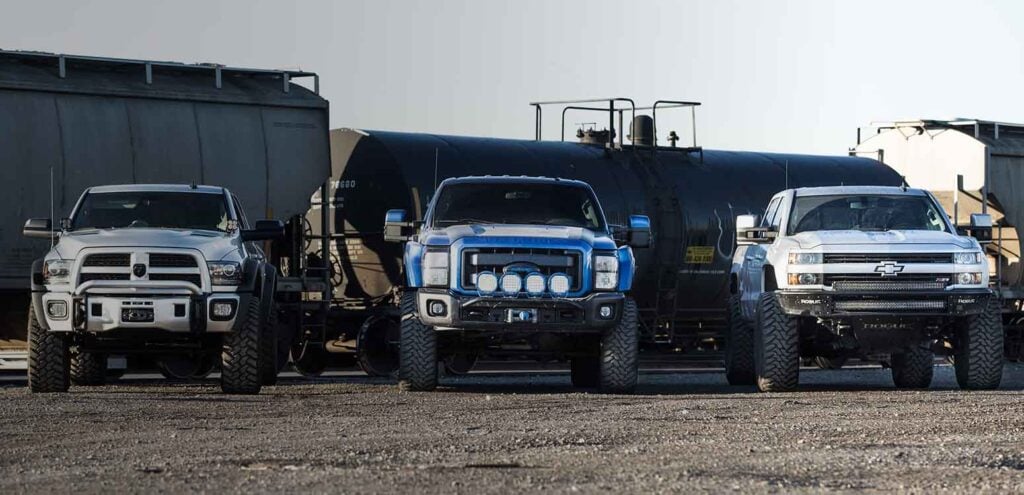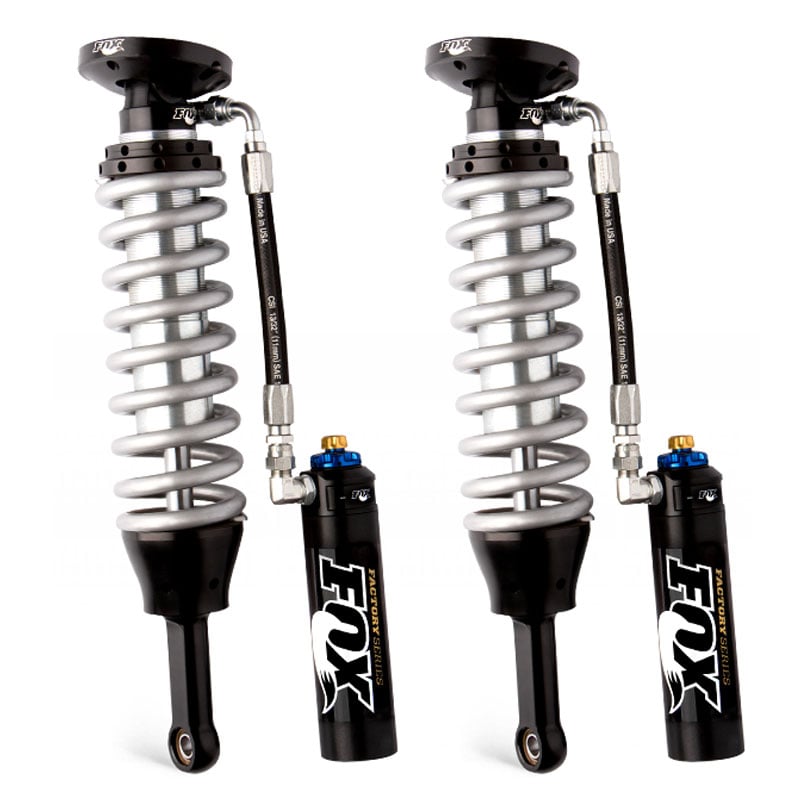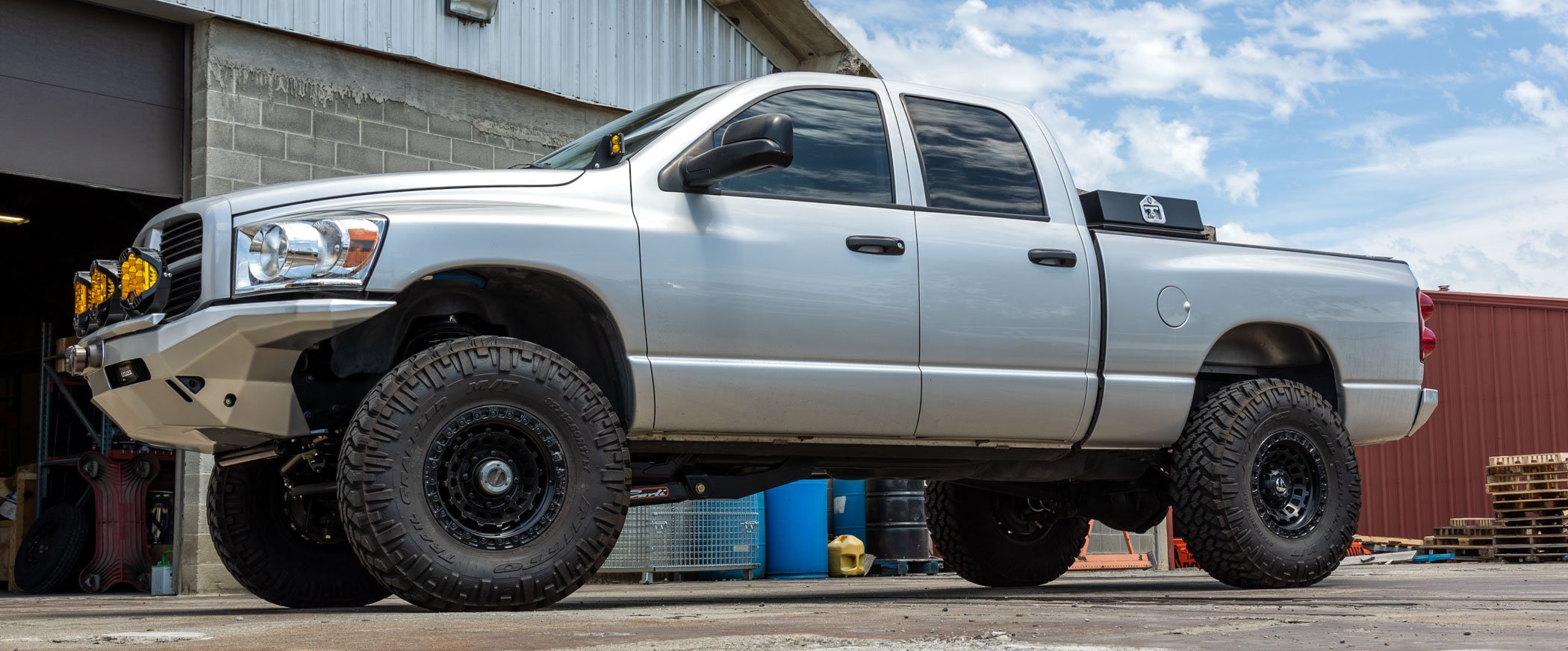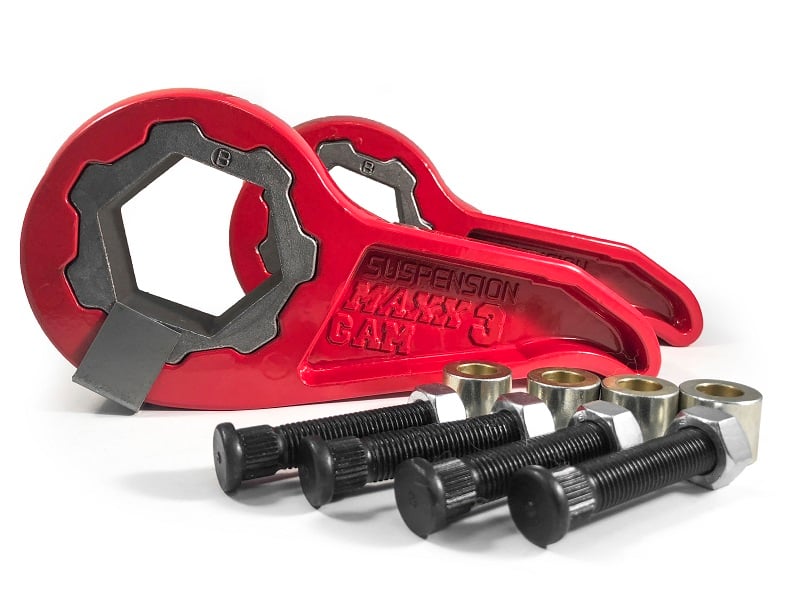Does a stock truck bring a smirk to your face? That stinkbug look with a jacked up bed while the front end looks for pennies isn’t just weird looking; it positions your front end in a diving situation before you even start hitting inconsistencies in the road. The easiest solution: Add a leveling kit. But if most truck owners can easily install a leveling kit in their driveway, why doesn’t the manufacturer just build the suspension at a correct height to begin with? There is a very simple reason for that stinkbug truck: Manufacturers need to ensure enough suspension spring rating for the maximum towing capacity and hauling rating of the truck—maximums that the great majority of owners will never get close to reaching. The idea behind the butts-up look is that when the rear suspension gets loaded down with a heavy trailer, the back end sits lower and makes the truck ride at a more leveled position. In a rear leaf-sprung truck, there are often overload leafs in the spring pack that act as a secondary spring rate once the rear is weighted down to a level stance. But if you’re using your truck for daily driving without a trailer, for off-road duty, or for lighter towing, you may find that rear is sitting too tall while the front isn’t quite tall enough. Thankfully, we have solutions—lots of them! And while this time may be a perfect opportunity to install a lift kit or long-travel suspension, most diesel trucks can accept 35-inch to 37-inch tires with the addition of a simple leveling kit, getting the desired result without a bunch of work. On top of that, most leveling kits do not void warranties in the way major suspension modifications can, meaning you can level your new truck without fear of losing valuable coverage.
Can I Install a Leveling Kit at Home?
Aside from replacing your truck or 4×4’s shocks or track bar (panhard rod), adding a leveling kit is one of the easiest ways to positively modify your suspension. And, in the case of coilovers, some leveling systems are as simple as replacing the shocks. With some hand tools, a lift or jack, and careful attention to instructions, most leveling kits and systems can be done in your home workplace of choice. That being said, there is one particular type of inexpensive leveling device that should be left to professional installers: Any kit that uses a spring spacer in an existing strut/coilover should be installed by a professional and not tried at home. Unfortunately, since this is one of the cheapest ways to lift a strut-supported vehicle, it’s tried more often at home by the owner than it should be.
Leveling Kit vs. Lift Kit
The main difference between a lift kit or suspension system and a leveling kit would not necessarily be the added height difference but instead how inclusive the kit is. Words like “kit” and “system” get thrown around synonymously, but a leveling kit usually comes with a block or spring to add height to the front end, and any sway bar, brake line, or shock extensions necessary. A suspension system or ‘lift kit’ generally consists of replacement springs, replacement shock absorbers, possibly replacement arms or links, and any necessary equipment to adapt this system to your truck or 4×4. A suspension system can add the same amount of lift as a leveling kit, but it usually adds more [height].

How Much Lift Does a Leveling Kit Provide?
Most leveling kits add anywhere from 1 to 3 inches of front lift to level out your truck, with the great majority adding around 2 inches. Due to the nominal amount of change in suspension height, new arms or links are not required.
Types of Leveling Kits
There are five ways to level a truck or 4×4, depending on what type of suspension it has and how much money you choose to spend. If your ride has independent front suspension (IFS) then you have either a coil spring/air bag, strut/coilover, or torsion bar holding the sprung weight of the vehicle. If you have a solid front axle, you have either a coil spring/air bag, coilover, or leaf spring suspending the front of your truck. With the type of suspension (solid axle or IFS) and spring device established, you can figure out what type of leveling kit will be best for you.

1.) Coilover / Strut Replacement
If your vehicle is supported with a strut or coilover, a performance replacement coilover shock with an adjustable spring collar will be your best option for added height with suspension improvement and performance. That being said, it is also the most expensive type of leveling device there is.
2.) Spacer / Block Addition
If your vehicle is supported by a coil spring, air bag, leaf spring, or strut/coilover, then the cheapest option—and sometimes the only option—is a block or spacer that sits on top of or below the spring device.
For a coil spring, a spacer is sandwiched with the coil in between the upper and lower coils buckets. It does not change the spring rate but it adds a difference in height.
For an air bag, a spacer is often the best option if you can not easily adjust the height of the air bag. It does not change the spring rate.
For a leaf spring, a spacer block can be added in between the leaf spring and axle. This requires new U-bolts. This is never advisable in a front suspension, but there are existing kits out there so you should be aware of them.
For a strut/coilover there are two types of spacers that can be found in the aftermarket. One puts a spacer puck either above the strut or below it. The other type of spacer is one that going onto the strut with the coil spring. This requires disassembly of the strut/coilover and reassembly of a strut with an almost volatile spring rate. Neither are good choices for an A-arm vehicle. Adding a spacer puck above or below the strut slightly changes the position of the pivot points, which may adversely affect the way the suspension rides. A spacer within the spring package of a strut will increase the spring rate and possibly decrease the amount of compression travel. In either instance, we would highly recommend going with a full replacement unit.
3.) Spring Replacement
The best way to level your vehicle is with a replacement spring. Whether it is a coil spring or leaf spring, a quality aftermarket unit can add the inches you want in addition to improving the ride with a softer spring rate or a progressive rate design. A replacement spring is more costly than a block or spacer, but it is almost always the better option. In a coilover/strut replacement, the spring is included.
4.) Torsion Key Replacement
In an independent, torsion-sprung front suspension there are torsion keys that sit under your vehicle and hold the torsion bars in a certain keyed position. By changing the position of that torsion bar, you can adjust the ride height of the vehicle. Replacement torsion bar keys are broached to hold the torsion bars at a different degree, changing the ride height.
5.) Shackle Replacement
In a leaf spring setup, you can replace the stock shackle with a longer one that will increase the lift of the vehicle. This also changes the pinion angle. In a front (leading) shackle setup, adding a longer shackle can change the pinion angle in a good way—to work with the increase in ride height. But on a rear shackle front leaf spring, a longer shackle will point the pinion down and increase the angle that the driveshaft’s U-joint has to deal with. The majority of front leaf spring suspensions use a rear shackle, so adding a longer shackle should be done cautiously.
Will I Need New Shocks?
New shocks are not usually required with a leveling kit, though some kits may come with shock replacements or extensions if needed. That being said, adding new shock absorbers is one of the best ways to improve the ride of your vehicle, no matter what it is.
Is Alignment Necessary Afterwards?
Some type of steering alignment is necessary for almost all leveling kits. While the truck has gotten taller, the steering knuckles have remained in the same relative place above the ground. The increase in distance requires a small adjustment to the steering linkage.


